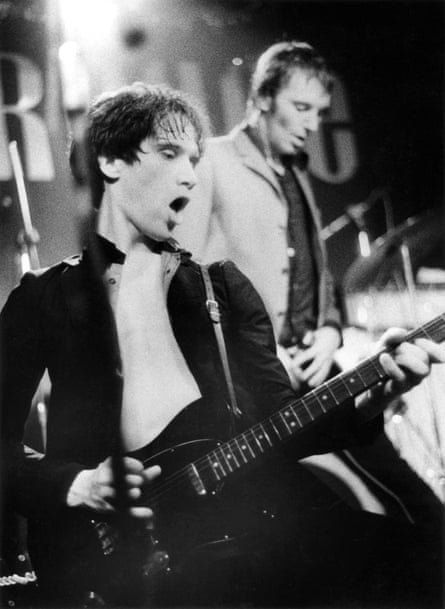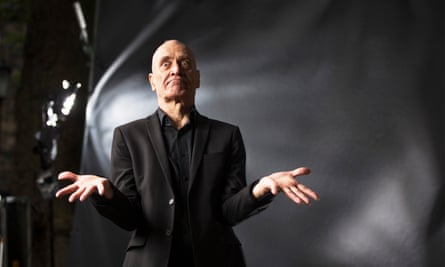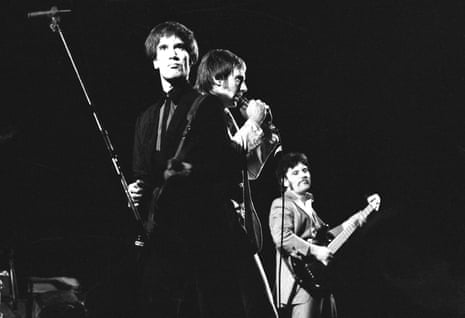The film-maker Julien Temple described the musician Wilko Johnson, who has died aged 75, as “one of the great English eccentrics, a great national treasure waiting to be discovered”. It was thanks partly to Temple’s 2009 documentary, Oil City Confidential, which traced the history of the Canvey Island band Dr Feelgood and Johnson’s role in it, that he enjoyed renewed acclaim towards the end of his life.
Not that fans of Dr Feelgood in the band’s mid-1970s heyday needed reminding of Johnson’s accomplishments. He was never a guitar virtuoso in the vein of Jeff Beck or Eric Clapton, but he was one of the most distinctive British players in the history of rock’n’roll, having perfected a hair-trigger style that combined stark, percussive chords with pin-sharp riffs. To that, Johnson added an intimidating stage presence. Invariably clad in a black suit, eyes staring out across the audience like searchlights, he roved around the stage with robotic remorselessness.
He developed a tight stage rapport with the Feelgoods’ vocalist Lee Brilleaux, who was helpfully signposted by his contrasting white – or once white, at least – suit. Johnson said he “felt like a lot of the power I had in whatever I was doing was radiating from him”. It was their partnership that drove the band to huge success in Britain just before the arrival of punk.
Dr Feelgood launched themselves on the back of the “pub rock” vogue, a back-to-basics mix of sweaty rock and rhythm & blues typified by the likes of Ducks Deluxe and Ian Dury’s band Kilburn and the High Roads. It was a refreshing antidote to the somnolent progressive rock of the era. Dr Feelgood released their debut album, Down By the Jetty, in 1975, containing nine of Johnson’s songs, including the singles Roxette and She Does It Right, neither of which got into the charts. They followed it later that year with Malpractice, which featured several blues and R&B non-originals alongside another batch of Johnson’s tunes. One of Johnson’s was their third single, Back in the Night, a perennial favourite in live shows. The album gave Dr Feelgood their first chart position (No 17), and proved influential on New York musicians such as Richard Hell, the Ramones and Blondie.

Since the stage was the natural home for the hard-gigging Feelgoods, it made sense for the next album to be a live recording. Stupidity (1976) was a mixture of their own songs and cover versions, not least Leiber & Stoller’s Riot in Cell Block No 9, which had become the vehicle for a trick by Johnson of mock-machine-gunning the audience with his guitar. Johnson was adamant that the recording should sound raw and live and should not be tarted up in post- production, a stance that paid off when it rocketed to No 1. To their own amazement, Dr Feelgood had become one of the biggest bands in Britain.
However, the album Sneakin’ Suspicion (1977) proved to be Johnson’s swansong with the band, following acrimonious arguments during its recording. In particular, Brilleaux objected to Johnson’s song Paradise, in which the songwriter, who had married Irene Knight when they were both teenagers, admitted that “I love two girls, I ain’t ashamed”. Johnson’s erratic and moody behaviour while on tour had already caused friction, and he left Dr Feelgood in April 1977. Sneakin’ Suspicion reached No 10 on the album chart, and in 1979 the group enjoyed a top 10 singles hit with Milk and Alcohol, but the whirlwind arrival of punk had made them look outmoded. “I look back on Dr Feelgood sometimes and I would do a lot of things differently,” Johnson said in 2012. “Oh man, I was intolerable.”
He was born John Wilkinson on Canvey Island, Essex. One of his earliest memories was of the 1953 floods, which hit low-lying Canvey badly and caused many deaths. His father, a gas-fitter, was “a stupid and uneducated and violent person”, according to his son, and died when Wilko was a teenager. Canvey became a romantic place in Johnson’s mind, with its lonely views of the Thames estuary overshadowed by the towers and blazing fires of the nearby Shell Haven oil refinery. Johnson and his contemporaries dubbed the area the Thames Delta, in homage to the Mississippi Delta, which spawned the blues musicians they admired.
He first began playing the guitar after watching the Shadows on television, then later was inspired by Mick Green, guitarist with Johnny Kidd & the Pirates. Green’s knack for mixing up lead and rhythm guitar parts had a clear influence on Johnson’s technique. Wilko instinctively began to play left-handed, but forced himself to switch to right-handed. When he found that playing right-handed meant he could not hold a plectrum, he perfected a way of flicking his fingernails across the strings, which helped him to play the speedy, slashing rhythms that became his stock-in-trade.

Wilko nurtured academic ambitions alongside musical ones. He attended Westcliff high school for boys (his mother “used to scrub floors at the gas company to pay for our grammar school uniforms”) and went to Newcastle University to study English. He wrote his own poetry and aimed to write novels, though he observed that his appreciation of great literature meant that “the presumption of trying it myself is inhibiting”. His conversation, which involved much gesticulation and dramatic facial expressions, would often be punctuated by quotes from Blake or Langland’s Piers Plowman, and he taught himself Old Icelandic in order to read the Icelandic Sagas. He spent some months teaching English at a secondary school around the time Dr Feelgood formed, but fell foul of the headteacher because of his long-haired, student-like appearance. Later in life, he developed a keen interest in astronomy and built an observatory on the roof of his home in Westcliff-on-Sea.
After university he travelled overland to India (partly inspired by hearing about his father’s experiences in the army on the north-west frontier), and soaked up his fair share of opium and eastern mysticism. Returning to Canvey, he played in a jug band with his brother, and met Brilleaux (then using his real surname, Collinson), future Feelgoods bassist John “Sparko” Sparks and the group’s manager-to-be, Chris Fenwick, who had formed a jug band of their own. Brilleaux’s outfit evolved into an electric R&B band, and they asked Wilko to join them on guitar. In 1971, Dr Feelgood was born.
In his post-Feelgood career, Johnson formed a new band, the Solid Senders, which played at the Front Row festival at the Hope & Anchor pub in Islington, London, alongside many of the new punk acts. Johnson was surprised and gratified to discover that many punk luminaries, including Joe Strummer and John Lydon, were Feelgood fans who had seen them as an influence.
The Solid Senders released an album on Virgin in 1978, but by 1980 Johnson had taken a job with Ian Dury’s Blockheads, and then formed the Wilko Johnson Band. Over the next 25 years the unit would release eight albums and an EP, mostly on minor European labels, though their main focus was playing live shows in Europe, Britain and Japan.

Temple’s documentary in 2009 had a galvanising effect on Johnson’s profile. He toured supporting the Stranglers in 2011, and played some sellout gigs at the Rhythm and Roots festival in Kilkenny. In 2012 he published an autobiography, Looking Back on Me, co-authored with Zoe Howe. He was also recruited for the HBO TV show Game of Thrones, appearing in four episodes as the royal executioner Ser Ilyn Payne. This called upon Johnson merely to look sinister and kill people, since Payne had had his tongue cut out and had no dialogue.
After being rushed to hospital in Southend for an unknown condition, Johnson was diagnosed with incurable pancreatic cancer in January 2013. He reacted with remarkable stoicism. Given 10 months to live, but having declined chemotherapy which might have given him a few more weeks, he talked frankly about his condition on Radio 4’s Front Row and arranged a string of farewell gigs that March. His philosophical attitude was perhaps shaped by the fact that Irene had died of cancer in 2004, and Johnson had never reconciled himself to her loss (“the only time I don’t feel heartbroken is when I’m playing,” he admitted).
Following the tour dates, he teamed up with the Who’s Roger Daltrey to make the album Going Back Home (2014), which included favourite Johnson songs from Dr Feelgood and his solo career. Both artists seemed to be goading each other on, since Johnson’s guitar work was as clipped and fiery as it had ever been, while Daltrey hurled himself into the songs with abandon. Daltrey commented that Johnson is “one of those British guitarists that only the Brits make. Wilko is a one-off, he really is.” The album reached No 3 in the UK, making it Johnson’s highest charting release outside Dr Feelgood.
He confessed that he thought it would be “the last thing I ever did”, but then later that year his story took a dramatic twist. Further tests revealed that he was suffering from a less virulent form of cancer than previously believed, and doctors were confident it could be operated on successfully. He underwent a complex nine-hour procedure that included the removal of a tumour weighing 3kg, and after a long convalescence was declared cancer-free.
“It’s so weird and so strange that it’s kind of hard to come to terms with in my mind,” he said. “Now, I’m spending my time gradually coming to terms with the idea that my death is not imminent, that I am going to live on.”

Paradoxically, the depression that he had suffered from since childhood had abated after his cancer diagnosis. When he got the all-clear, the depression returned. “I knew I was really getting better from the cancer when I started getting depressed again,” he said.
In 2015 Johnson made another film with Temple, The Ecstasy of Wilko Johnson, focusing on his unexpected survival. In 2016 he published the memoir Don’t You Leave Me Here, and in 2018 he released the solo album Blow Your Mind. He was still performing regularly with his band until September this year.
He is survived by his sons, Matthew and Simon.
Wilko Johnson (John Andrew Wilkinson), guitarist and songwriter, born 12 July 1947; died 21 November 2022

Comments (…)
Sign in or create your Guardian account to join the discussion